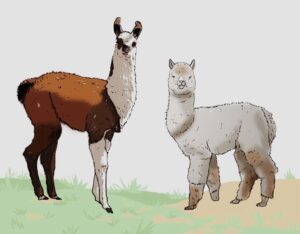
At Ashtonelle Alpacas we only keep and breed huacaya alpacas – nevertheless, if I had a £1 for every time someone asks, “How are your llamas?” I could have many many more alpacas!
Both species are primarily found in South America, and are part of the camel family, Camelidae. Alpacas and llamas are two of the four lamoid species—the other two species, vicuña and guanaco, are their wild cousins. Interestingly, all four species are able to interbreed and create fertile offspring. While often confused (and I can vouch for that), alpacas and llamas differ in key ways. The most-distinguishing physical differences between alpacas and llamas are their size, their hair, and their face and ear shapes. Also, they differ in disposition, which affects the way humans have used them over centuries.
The most-noticeable difference between the two animals is their sizes. Alpacas are smaller, around 90 cm (35 inches) high at the shoulder and between 55 and 95 kg (121 to 143 pounds). Llamas are much bigger at about 120 cm (47 inches) at the shoulder and about 113 kg (250 pounds). Their faces are also dissimilar: alpacas have small, blunt faces with short ears, while llamas have more-elongated faces with banana-sized ears. Think llama banana! Or banana llama!
For more information on llamas, visit The British Llama Society.
